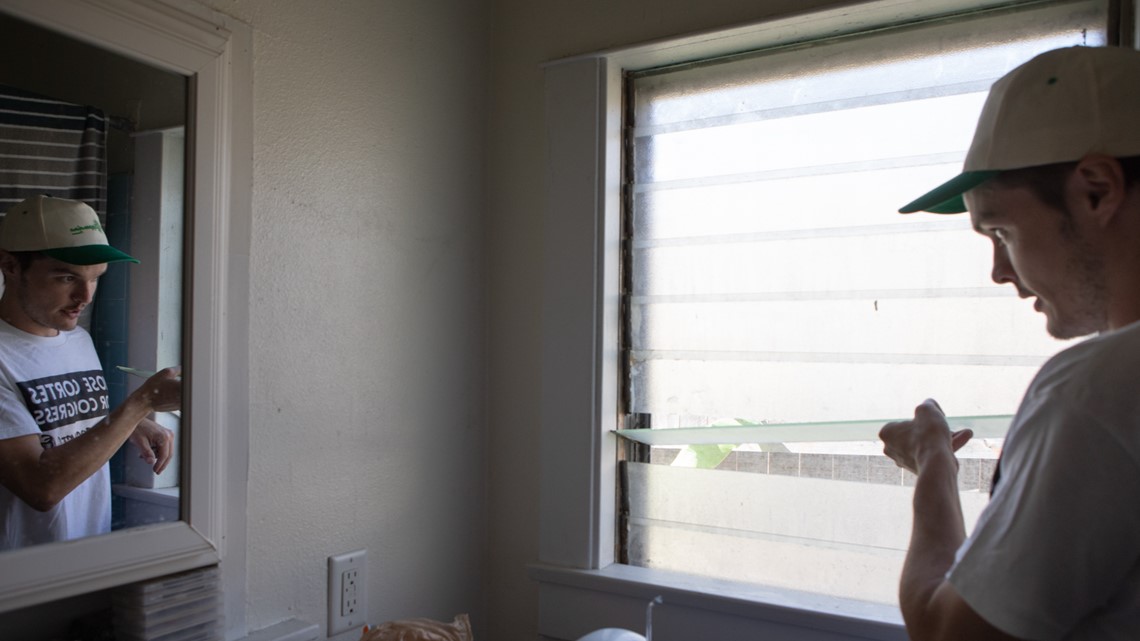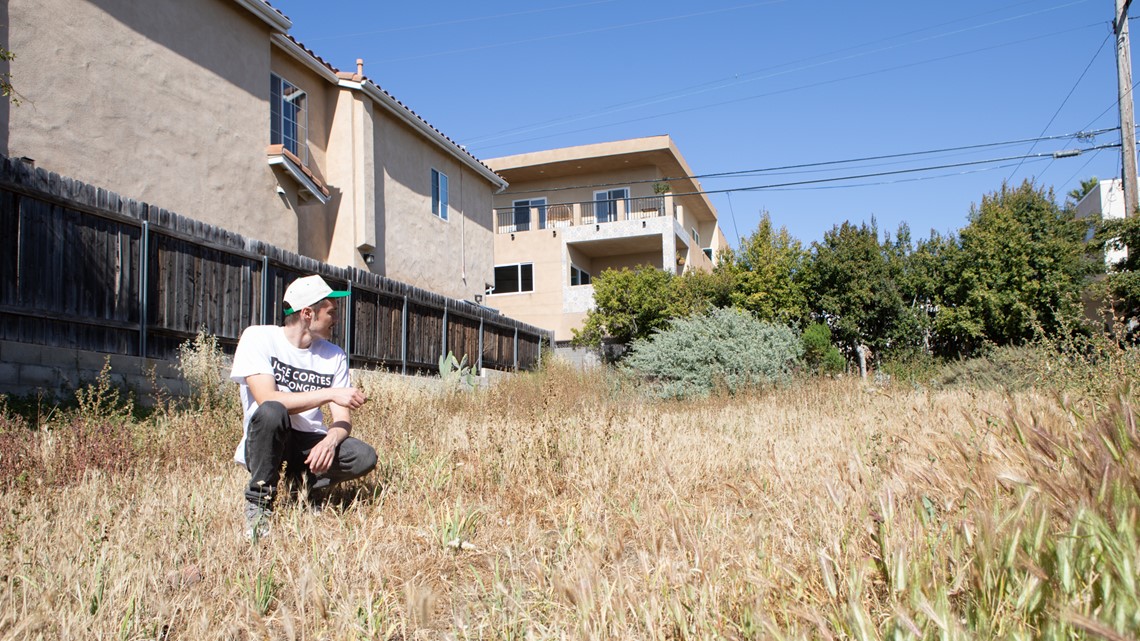SAN DIEGO COUNTY, Calif. — David Zimmerman had big plans when he moved into a four-bedroom house in North Park. He would split the $2,500 monthly rent three ways with roommates and take full advantage of the backyard — starting a garden, hosting parties, maybe even raising chickens.
Zimmerman only had a verbal agreement to live there, but he said the property owner was his friend’s mom. He said he didn’t think twice about it because she made him feel part of the family.
But a week after moving in, San Diego was hit with one of the coldest days on record in March, and a broken window and busted heater forced Zimmerman to wrap himself in blankets and sleep on the couch in the living room, the warmest place in the house he could find.
So, the 30-year-old tenant complained to his friend’s mom. He said he wasn’t being aggressive; he was just tired of being cold.
Not long after his complaints, Zimmerman said he received a notice to vacate May 1. He said his landlord is using a no-fault eviction to remove him from the 1,200-square-foot property to make substantial repairs and pull it off the rental market.
While Zimmerman’s situation is unique, data and interviews suggest he is one of hundreds of other tenants caught in a wave of no-fault evictions in San Diego County, and cities like San Diego and Chula Vista are taking action to prevent abuse of the system and keep people housed.
An inewsource analysis of court data found that the average number of residential eviction filings per business day has been trending upward since last September, around the same time when most local and state COVID-related eviction protections expired.
Right now, as long as non-paying tenants have applied for rental assistance, they can’t be evicted in most cases, said Gilberto Vera, senior attorney of the housing team with Legal Aid Society of San Diego.
But tenants can be evicted for other reasons, or no reason at all.
Vera said the Legal Aid Society has seen an increase in the number of situations similar to the one Zimmerman is facing — an owner who is removing a tenant with a no-fault eviction, citing the need to substantially remodel the property and the desire to pull it off the market.
In fact, nearly a quarter of the calls for help to the Legal Aid Society involve various types of no-fault evictions, according to data collected by the law firm.


But there aren’t any enforcement mechanisms to prevent a landlord from saying they need to evict for substantial repairs, or because they want to stop renting the property, only to turn around and rent to someone else at a higher rate.
“Tenants here in our county are vulnerable from being exploited by their landlords because of these loopholes,” Vera said.
Last week, the San Diego City Council took steps to close those loopholes by requiring that no-fault evictions meet certain conditions, such as providing extra notice and following rules to pull a property off the market. The new moratorium takes effect May 19 and will last until Sept. 30, or 60 days after the local state of emergency ends, whichever comes first. Chula Vista is preparing to take similar steps next month.
But some rental property owners are calling it a political move. Lucinda Lilley, president of the Southern California Rental Housing Association, said owners have been blindsided with yet another layer of restrictions that will carry unintended consequences and threaten the housing ecosystem.
“We recognize that there are extremes in both renters and in rental housing providers, and certainly we acknowledge that there may be bad actors,” Lilley said, “but there are other ways to manage that.”
This moratorium ties the hands of rental housing providers by restricting what they can do with property they own, she said, adding that cities and counties should instead require mediation before an eviction can be filed.
But the ultimate goal is to prevent people from becoming homeless in the middle of a pandemic due to no fault of their own, said Jose Lopez, director of San Diego’s Alliance of Californians for Community Empowerment.
“When we’re talking about no-fault evictions, these are evictions for tenants who have done nothing wrong,” Lopez said.
‘This can’t come soon enough’
Zimmerman’s troubles started at the beginning of the year with what appeared to be a great deal.
He had heard about the house in North Park — a much bigger space than what he had in University Heights. His friend’s mother, Penny Yasuda, had just bought the property at the beginning of the year. While Yasuda did not respond to interview requests, there’s no evidence to suggest that the eviction was not compliant with the law.
According to Zimmerman, Yasuda wanted to rent the space out for $2,500 beginning in March. But the soonest he and two other roommates could move in and afford that rate was in May. Zimmerman said she agreed to meet in the middle, asking for only $900 a month for March and April, and then bumping the rent up to $2,500 a month when the roommates arrive in May. But none of that was in writing.
Zimmerman said he was drawn to the backyard, swimming with ideas of where to start growing vegetables and the best place to put the chicken coop. Plus, this deal wouldn’t have cost him any more a month than he had already been paying in University Heights. He jumped on the opportunity, he said.


Now he’s facing an eviction come May 1, roughly two weeks before the city’s moratorium takes effect. As a research associate for UC San Diego, Zimmerman said he works remotely and relies on stable power, internet and housing to make a living. He said his plan is to dig in and hope that any eviction proceedings would happen after the moratorium takes effect.
But he could still be protected, said Erin Rounds, managing attorney and owner of the Tenants Legal Center.
Based on how the law is written, Rounds said every tenant in the city of San Diego should be protected from a no-fault eviction whether they’ve been living somewhere for three months or three years, with or without a lease. And a judge will have to decide whether this moratorium should apply to someone who was already served with a no-fault eviction before it takes effect May 19.
“Even the attorneys right now don’t really know quite how this is going to be handled,” she said.
Nonetheless, Zimmerman said he’s worried about the baggage that will come with resisting an eviction.
“It makes it so much more difficult to find a future rental,” he said.
The anxiety of it all keeps him up at night, he said. He feels exhausted throughout the day and struggles with productivity at work.
“I think for a lot of people in San Diego, this can’t come soon enough,” he said.
‘It’s my property’
Roughly 64,000 San Diegans are still out of work, according to SANDAG, and rental debt continues to pile up in a county where census data shows nearly half of all housing units are occupied by renters. Statewide, research shows 740,000 households have racked up $3.5 billion in rental debt since the beginning of February.
But while some eviction protections expired last September, most tenants are still covered as long as they have applied for rental assistance.
So far, more than $196 million in rent relief has benefitted nearly 17,000 households in the city of San Diego, and 9,000 are still awaiting approval. The county’s rent relief program has doled out more than $193 million to help over 20,000 households, with $20 million still pending approval.
And now, San Diego’s moratorium on no-fault evictions is an attempt to add an additional layer of protection for people who are paying rent and fulfilling all the obligations of their lease.
But it makes certain exceptions. A landlord can evict a tenant to remove the property from the rental market, as long as they provide six months’ notice and vacate all units on the property. This is to prevent a landlord from targeting a particular person and allowing everyone else to stay, said Vera, the lawyer.
A landlord could also evict a tenant so that they, or an immediate family member — grandparents, parents or children — can move into the property, but they would need to provide 90 days’ notice.
Residential evictions climbing in San Diego County
The average number of residential unlawful detainer filings per business day has been trending upward since last September, around the time when most local and state COVID-related eviction protections expired.
Even that poses a problem for property owners faced with a situation like Renee Burnett.
She said she owns one property in the city, a four-bedroom, two-and-a-half-bathroom home in Southeast San Diego that she inherited from her aunt. She has rented it out to the same family for the past nine years, and they’ve struggled to pay rent for the past six, she said.
But it’s not about the money, she said. She’s trying to evict them now because her sister is ill and experiencing homelessness, and relocated to San Diego to be closer with family. But because her sister isn’t considered an immediate family member under the city’s moratorium — only grandparents, parents and children — Burnett wouldn’t qualify for the exception.
“I mean, come on, who is more immediate than your brother or sister?” she said in an interview, adding, “and it’s my property, it’s my property.”
Burnett, who lives in Chula Vista, said she sent an email to Mayor Todd Gloria and the City Council before the moratorium passed, explaining her sister’s poor health.
“What makes this situation even worse is that my sister’s husband and primary caregiver lives in his car and sleeps in the park, which is three houses away from my rental property,” she said in the email. “My aging mother shelters my sister at night.”
She ended her note with, “not all landlords are real estate moguls,” and asked the City Council not to pass the moratorium. It wound up passing 6-1, with Councilmember Chris Cate voting no, and councilmembers Joe LaCava and Raul Campillo recusing themselves.
Even so, Burnett said she served her tenants with a 90-day notice to vacate April 13, ahead of the final vote. She said she used a no-fault eviction, citing owner or immediate family member move-in as the reason, hoping that something will change and allow it to go through.
“We’ll see what happens when it’s all said and done,” she said. “I’ll be really mad if something happens to my sister before then.”
inewsource is a nonprofit, independently funded newsroom that produces impactful investigative and accountability journalism in San Diego County. Learn more at inewsource.org.
WATCH RELATED: San Diego City Council to vote on 'no-fault' eviction moratorium



